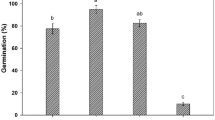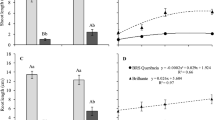Abstract
SEVERAL workers1–3 have shown that, in the field, heather (Calluna vulgaris Salisb.) is found most frequently and attains its maximum development on soils the reactions of which are about pH 4. I have examined the germination and the subsequent seedling development of Calluna seeds planted on agar media adjusted to give a range of reactions. A quantity of 1 per cent British agar was prepared with a form of Knop's solution. This was divided equally between nine flasks. The contents of these were adjusted to pH 2, 3, 4, 5, 6, 7, 8, 9 and 10, respectively, by the addition of the requisite quantities of sulphuric acid or caustic soda. After adjustment, the agar in each flask was poured into six 1-in. boiling tubes to give a depth of agar of about 1½ in. The tubes were plugged and the agar allowed to set. A liberal sowing of Calluna seeds was then made in all tubes.
This is a preview of subscription content, access via your institution
Access options
Subscribe to this journal
Receive 51 print issues and online access
$199.00 per year
only $3.90 per issue
Buy this article
- Purchase on Springer Link
- Instant access to full article PDF
Prices may be subject to local taxes which are calculated during checkout
Similar content being viewed by others
References
Fraser, G. K., Bull. Forest. Comm. No. 15 (1933).
Heath, G. H., and Luckwill, L. C., J. Ecol., 26 (1938).
Olsen, C., C.R. Carlsberg Lab., 15 (1923).
Author information
Authors and Affiliations
Rights and permissions
About this article
Cite this article
POEL, L. Germination and Development of Heather and the Hydrogen Ion Concentration of the Medium. Nature 163, 647–648 (1949). https://doi.org/10.1038/163647b0
Issue Date:
DOI: https://doi.org/10.1038/163647b0
Comments
By submitting a comment you agree to abide by our Terms and Community Guidelines. If you find something abusive or that does not comply with our terms or guidelines please flag it as inappropriate.



